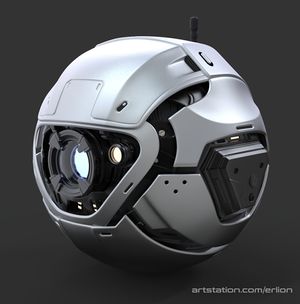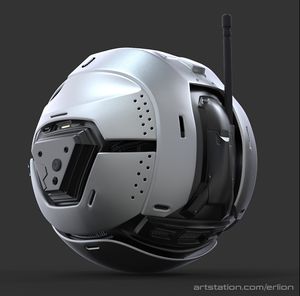No edit summary |
m (Cyclops moved page Teufel Probe to TEUFEL Probe) |
(No difference)
| |
Revision as of 04:44, 21 June 2023
There are multiple variants of this technology, please refer to Probe Disambiguation for a list of the variants. |


- Cruising Speed
- 300 kph
- Maximum Speed
- 1000 kph
- Nominal Range
- 1 Meter - 1 AU from Vessel
- Maximum Range
- 21 AU Control
2.5 ly Relay
The newly developed TEUFEL (Tracking and Evasive Unmanned Field Exploration Lookout) Sensor Probe is an entirely new design in remote sensing and threat assessment. These small, 1.7 meter diameter truncated-sphere probes are launched from a ship. The probes, made of energy absorbent materials, are extremely difficult to detect and operate on a micro-gravity displacement generated within the core by a Spacial Variance Reactor. The simple onboard AI system enables operator command input.
Capabilities
- Operational Capacity
- A ship can handle up to 20 TEUFEL Probes operating simultaneously.
- Group Operation
- Capable of operating independently or in groups to enhance sensor strength through array pattern formation.
- Rapid Direction Change
- Can execute sudden direction changes in three-dimensional space within microseconds, making their movement paths hard to track.
- Adaptive Pathing
- Follows pre-programmed paths, often erratic, with ability to plot random or semi-random course changes for evasion and varied sensor readings.
- Sensor Suite
- Equipped with a comprehensive range of short and long-range sensors, able to detect and analyze various types of data.
- Refractive Warp Drive
- Able to use a ship's existing warp field to travel through space at warp speed, matching the ship's speed without requiring their own warp drives. This enables them to achieve the same speed as the ship within a 21 AU range.
- Communications
- Employs precise point-to-point subspace enhanced direct beam communications, similar to laser pulse communications but at faster-than-light speeds. Also utilizes subspace high frequency burst communications for communication with their vessel or with each other as required.
- Neural Net Communication
- Developed independently via a neural net algorithm, their inter-probe communication adapts to suit each situation. Probes from the same ship share a unique communication language.
- Encryption and Security
- Uses a multi-dimensional fractal encryption algorithm that routinely alters timing and frequency range of all subspace communications. Encryption keys are frequently rotated, synced at launch time. Also uses a signal authentication key tied to the ship's transponder code.
- Offensive Capability
- In extreme circumstances, the probes can be commanded to overload their power cores, causing sizable explosions. Coordinated detonations can serve as a powerful weapon.